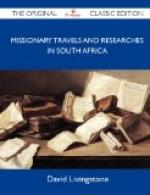Chapter 3.
Departure from Kolobeng, 1st June, 1849—Companions—Our Route— Abundance of Grass—Serotli, a Fountain in the Desert—Mode of digging Wells—The Eland—Animals of the Desert—The Hyaena—The Chief Sekomi—Dangers—The wandering Guide—Cross Purposes—Slow Progress—Want of Water—Capture of a Bushwoman—The Salt-pan at Nchokotsa—The Mirage—Reach the River Zouga—The Quakers of Africa—Discovery of Lake Ngami, 1st August, 1849—Its Extent—Small Depth of Water—Position as the Reservoir of a great River System—The Bamangwato and their Chief—Desire to visit Sebituane, the Chief of the Makololo—Refusal of Lechulatebe to furnish us with Guides—Resolve to return to the Cape—The Banks of the Zouga—Pitfalls—Trees of the District—Elephants—New Species of Antelope—Fish in the Zouga.
Such was the desert which we were now preparing to cross—a region formerly of terror to the Bechuanas from the numbers of serpents which infested it and fed on the different kinds of mice, and from the intense thirst which these people often endured when their water-vessels were insufficient for the distances to be traveled over before reaching the wells.
Just before the arrival of my companions, a party of the people of the lake came to Kolobeng, stating that they were sent by Lechulatebe, the chief, to ask me to visit that country. They brought such flaming accounts of the quantities of ivory to be found there (cattle-pens made of elephants’ tusks of enormous size, &c.), that the guides of the Bakwains were quite as eager to succeed in reaching the lake as any one of us could desire. This was fortunate, as we knew the way the strangers had come was impassable for wagons.
Messrs. Oswell and Murray came at the end of May, and we all made a fair start for the unknown region on the 1st of June, 1849. Proceeding northward, and passing through a range of tree-covered hills to Shokuane, formerly the residence of the Bakwains, we soon after entered on the high road to the Bamangwato, which lies generally in the bed of an ancient river or wady that must formerly have flowed N. to S. The adjacent country is perfectly flat, but covered with open forest and bush, with abundance of grass; the trees generally are a kind of acacia called “Monato”, which appears a little to the south of this region, and is common as far as Angola. A large caterpillar, called “Nato”, feeds by night on the leaves of these trees, and comes down by day to bury itself at the root in the sand, in order to escape the piercing rays of the sun. The people dig for it there, and are fond of it when roasted, on account of its pleasant vegetable taste. When about to pass into the chrysalis state, it buries itself in the soil, and is sometimes sought for as food even then. If left undisturbed, it comes forth as a beautiful butterfly: the transmutation was sometimes employed by me with good effect when speaking with the natives, as an illustration of our own great change and resurrection.




